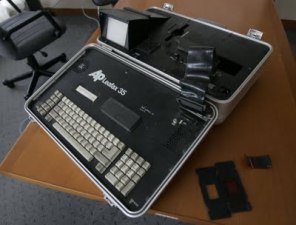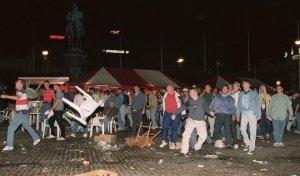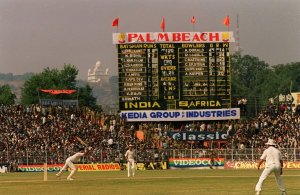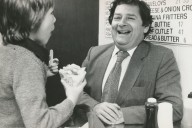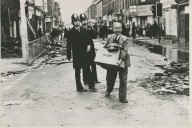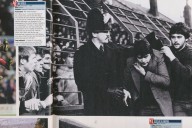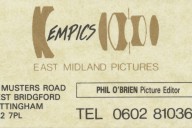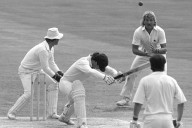
In the late 1980s, there was a transformation in the world of national newspapers. New titles, such as The Independent and Today came in to the market – and Rupert Murdoch fought the battle of Wapping to help rid the industry of some terrible, union backed practices (see “On the Wire – how many men does it take to send a picture?”).
For me, and my agency – EMPICS, this gave fresh opportunities. These new papers, the disintegration of union stranglehold and innovative technology led to an exciting new phase of the business.
In 1989, I travelled to Boston, US, to meet with Bob Caspe, the founder of Leaf Industries. Bob had worked closely with the Associated Press to create a machine that packed into a Halliburton case and could transmit a colour negative over a phone line. The process for a single colour image took 30 minutes – but it was revolutionary at the end of the 80s.
Overnight, our agency had access to the newest technology – and a market with an appetite to use colour pictures. We decided to focus our efforts on international sport. I’d only got a passport in 1987 (at the age of 25), so my new-found desire to travel internationally fitted in well with this strategy.
The technology had its issues – especially getting reliable phone lines back to base from distant countries. Many hours were spent in Eastern European hotel rooms trying to get a line out to the UK to transmit images. Then the nerve-jangling experience of hoping that the line didn’t drop or get interrupted in the 30 minutes it took to send each image.
The other big challenge to get colour pictures transmitted was finding a suitable place to process colour film. This ideally required electricity and warm water … but often had to be done without either. The venue was inevitably a hotel or public toilet.
From 1989 through to hanging up my cameras in 1994, I worked in 35 different countries – and became an expert on toilet facilities. These could range from the polished marble of a 5-star hotel to a public lavatory at a cricket ground in India!
Three experiences spring to mind…..
The first is at the top end of the market. During the 1992 European Football Championships in Sweden, I had a lovely marbled bathroom in a top hotel in Malmo. It was full of the top brass of football – and I was fortunate one morning to sit and have breakfast with England football legend Bobby Moore.
Processing colour film involved lots of fairly corrosive chemicals – it was always a challenge to get them on to planes (would be impossible these days). The powdered ones looked like you had a case full of cocaine – and the liquid ones were nasty substances (called names like Bleach Fix).
One of the tricks of getting film processed quickly to deadline was to dip the wet processed film in Methylated Spirits (that purple, smelly alcohol) – and then squeegee off with a chamois leather. The Meths was kept in a tupperware tray – and on this occasion, I chose the bottom of a nice marble shower tray to place this in.
During the tournament, there was the inevitable drink fueled hooliganism by England football fans. One Saturday night, I managed to get some pictures of England’s finest “in action” – and headed back to the hotel. I quickly processed the film – and spent the rest of the night wiring images. The picture of a chair spinning through the air made many front pages in the UK and Sweden.
In the morning, I went to take a shower – and removed the tub of Meths to find a deep purple stain on the lovely marble shower base. I scrubbed and scrubbed – but the stain would not move. The bill from the hotel to replace the shower tray certainly ate into the profits from my riot pictures!
The worst place I had to process a film was in the public toilets in Gwalior, India. We travelled up to Gwalior – quite a remote town famous for its Sikh Temple – to cover India playing South Africa. It was South Africa’s first sporting tour since the release of Nelson Mandela and the end of apartheid.
The phone lines were impossible – and there was absolutely nowhere to set up and process film. In the end, the public toilets shared by thousand of cricket fans were the only option. It was definitely my most primitive colour film processing experience.
Finally, there are some experiences in toilets that make it worthwhile. In 1993, I was in Las Vegas to cover the World Cup Soccer draw (the tournament was in the US the next year, 1994). There were only limited passes, so my colleague did the photography and I was in charge of processing. It was a glittery Las Vegas affair – with many stars on stage to complement the drawing of the teams to set groups the tournament.
I found a nice toilet this time. Still a public one – but not many visitors and very clean. Everything seemed fine, until a door opened and a very large, ominous looking black guy walked in with a short black guy. I looked up from processing – and they both went in to a toilet cubicle (think they call them stalls in the US) together. I wondered what was happening. Was it a drug handover? Or something else?
When the door finally opened again – I looked up (trying not to appear too interested). This time, I saw the smaller guy head on – it was Stevie Wonder … and the big guy was his minder! He’d been having a comfort break before going on stage!
[Since writing this article, I have had a few pictures submitted by other photographers who were on the road with me during the late 80s/early 90s. My thanks go to Eddie Keogh (a pioneer of colour digital transmission as Today’s sports photographer), Simon Bellis (an East Midlands based photographer who I shared many a beer with) and Chris Blishen (whose company delivered digital camera solutions).]
[Also, Rob Taggart at The Associated Press kindly sent me a picture of this UPI wire transmitter doing its work. Analogue transmission of a colour picture required this noise to go on for 30 minutes each picture – it brings back memories!]
My last “proper job” was in 1983-5. I was a photographer at the Leicester Mercury. It was one of the most enjoyable times of my life. Working within a community, making connections, then gradually gaining trust and respect is a rewarding process.
In 1981, I started my first job after school as a Trainee Press Photographer at Mercury Press Agency in Liverpool. I’d not bargained for my first week in employment to involve the coverage of some of the worst rioting on mainland Britain. I’ll always remember the phone ringing late at night after the family had […]
I lived in a council house on the ring road in Liverpool (Queens Drive) – and had very supportive parents (although I might not have thought so at the time). I went to a Catholic Boys’ Grammar School, St Francis Xavier’s – I and was very religious (up until the moment I was 18 – […]
In 1985, I was a 22-year-old press photographer in a well-paid and rewarding job at the Leicester Mercury. I had excellent colleagues – and a very comfortable life. However, it was not enough for me – and I wanted to work for National Newspapers and create my own business. So I set out to create […]
It’s amazing how easy it is to take and send high-quality photos these days. You can pick up an iPhone, take a snap and with a couple of clicks send the image around the world. It wasn’t always that simple – here’s a tale from 1985 (just over 25 years ago) when taking and transmitting […]
